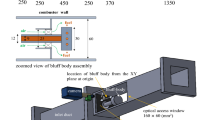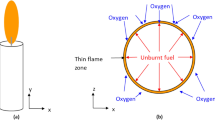Abstract
A high-speed camera system is used to observe the diffusion flame of a Bunsen burner in linear motion. The resultant sequence of instantaneous motion pictures of the flame accelerating at 3.60 m/s2 is processed and used to study the change in the flame area and specific floor area of the flame over different temperature ranges. The results indicate that the total flame area increases in the fuel control zone as the velocity increases over the range of experimental speeds employed (<0.90 m/s); then the total area quickly decreases in the transition region and is stable in the cross-flow wind control zone. As the velocity of the fire source increases, the low-temperature and specific floor areas adopt more dominant positions in the low-speed fuel control zone. In the high-speed cross-flow wind control zone, the area of the high-temperature zone and specific floor area take the dominant positions. The transformation between the two situations occurs in the transition zone. The cross-flow wind increases the high-temperature specific floor area of the fire compared to that of a stationary fire; the consumption in the moving fire also becomes correspondingly more concentrated and fierce.
Similar content being viewed by others
References
S. M. Mahmoud et al., “Simultaneous Planar Measurements of Temperature and Soot Volume Fraction in a Turbulent Non-Premixed Jet Flame,” Proc. Combust. Inst. 35 (2), 1931–1938 (2015).
C. Aalburg, F. J. Dies, G. M. Faeth, et al., “Shapes of Nonbuoyant Round Hydrocarbon-Fueled Laminar-Jet Diffusion Flames in Still Air,” Combust. Flame 142 (1/2), 1–16 (2005).
Y. Yan, G. Lu, and M. Colechin, “Monitoring and Characterisation of Pulverised Coal-flames Using Digital Imaging Techniques,” Fuel 81 (5), 647–656 (2002).
F. Liu and J. X. Wen, “The Effect of Turbulence Modelling on the CFD Simulation of Buoyant Diffusion Flames,” Fire Saf. J. 37 (2), 125–150 (2002).
B. T. L. Yelverton and W. L. Roberts, “Soot Surface Temperature Measurements in Pure and Diluted Flames at Atmospheric and Elevated Pressures,” Exp. Therm. Fluid Sci. 33 (1), 17–22 (2008).
L. K. Sze, C. S. Cheung, and C. W. Leung, “Temperature Distribution and Heat Transfer Characteristics of an Inverse Diffusion Flame with Circumferentially Arranged Fuel Ports,” Int. J. Heat Mass Transf. 47 (14–16), 3119–3129 (2004).
G. T. Linteris and I. P. Rafferty, “Flame Size, Heat Release, and Smoke Points in Materials Flammability,” Fire Saf. J. 43 (6), 442–450 (2008).
L. Hu, X. Zhang, Q. Wang, and A. Palacios, “Flame Size and Volumetric Heat Release Rate of Turbulent Buoyant Jet Diffusion Flames in Normal-and a Sub-Atmospheric Pressure,” Fuel 150, 278–287 (2015).
F. G. Roper, “Prediction of Laminar Jet Diffusion Flame Sizes. 1. Theoretical Model,” Combust. Flame 29, 219–226 (1977).
B. Lou, Y. Xu, and Zh.-G. Lin, “Image Characteristic Analysis of Moving Fire Diffusion Flame in Circular Motion,” J. Combust. Sci. Technol. 19 (1), 60–66 (2013).
H. C. Zhou, F. Sheng, S. D. Han, et al., “A Fast Algorithm for Calculation of Radiative Energy Distributions Received by Pinhole Image-Formation Process from 2D Rectangular Enclosures,” Numer. Heat Transf. Pt A: Applications 38 (7), 757–773 (2000).
H. C. Zhou, F. Sheng, S. D. Han, et al., “Reconstruction of Temperature Distribution in a 2D Absorbing Emitting System from Radiant Energy Images,” JSME Int. J. Ser. B 43 (1), 104–109 (2000).
X. F. Cheng and Z. Zhou, “Study on Measurement Principle of Temperature by Three Primary Colors,” Sci. China, Ser. E: Technol. Sci. 40, 518 (1997).
B. Lou, Y. Qiu, and J. Xu, “Characteristics of Diffusion Flames with Accelerated Motion,” Therm. Sci. 20 (6), 2079–2090 (2016).
M. V. Choi et al., “Simultaneous Optical Measurement of Soot Volume Fraction and Temperature in Premixed Flames,” Combust. Flame 99, 174–196 (1994).
S. Collins, “Advanced Flame Monitors Take on Combustion Control,” Power 10, 75–77 (1993).
R. F. Huang and M. J. Yang, “Thermal and Concentration Fields of Burner-Attached Jet Flames in Cross Flow,” Combust. Flame 105 (1/2), 211–224 (1996).
M. R. Johnson and L. W. Kostiuk, “Efficiencies of Low-Momentum Jet Diffusion Flames in Crosswinds,” Combust. Flame 123 (1–2), 189–200 (2000).
D. Casti˜neira and T. F. Edgar, “Computational Fluid Dynamics for Simulation of Wind-Tunnel Experiments on Flare Combustion Systems,” Energy Fuels 22 (3), 1698–1706 (2008).
F. Huang and M. Wang, “Characteristic Flow Modes of Wake-Stabilized Jet Flames in a Transverse Air Stream,” Combust. Flame 117 (1–2), 59–77 (1999).
Author information
Authors and Affiliations
Corresponding author
Additional information
Original Russian Text © B. Lou, Y. Wang, X.F. Long, F. Tian.
Published in Fizika Goreniya i Vzryva, Vol. 53, No. 5, pp. 31–39, September–October, 2017.
Rights and permissions
About this article
Cite this article
Lou, B., Wang, Y., Long, X.F. et al. Area Rules for the diffusion flame of a moving Bunsen burner corresponding to different temperature ranges. Combust Explos Shock Waves 53, 517–525 (2017). https://doi.org/10.1134/S0010508217050045
Received:
Published:
Issue Date:
DOI: https://doi.org/10.1134/S0010508217050045




